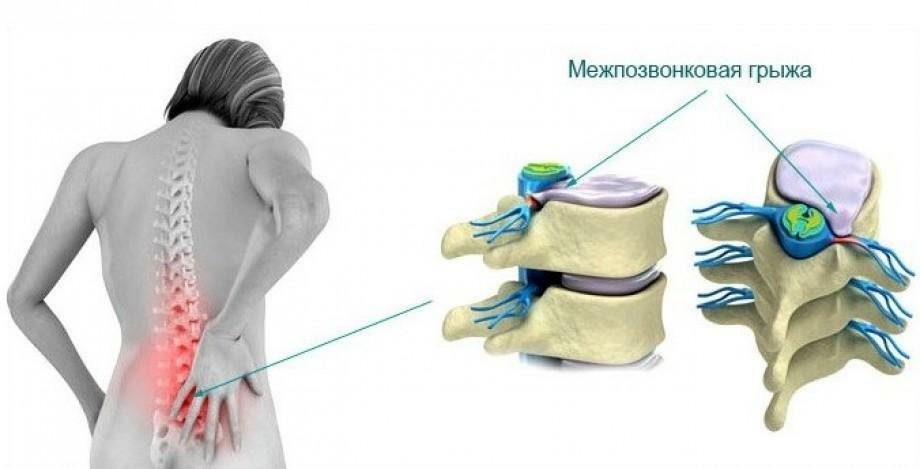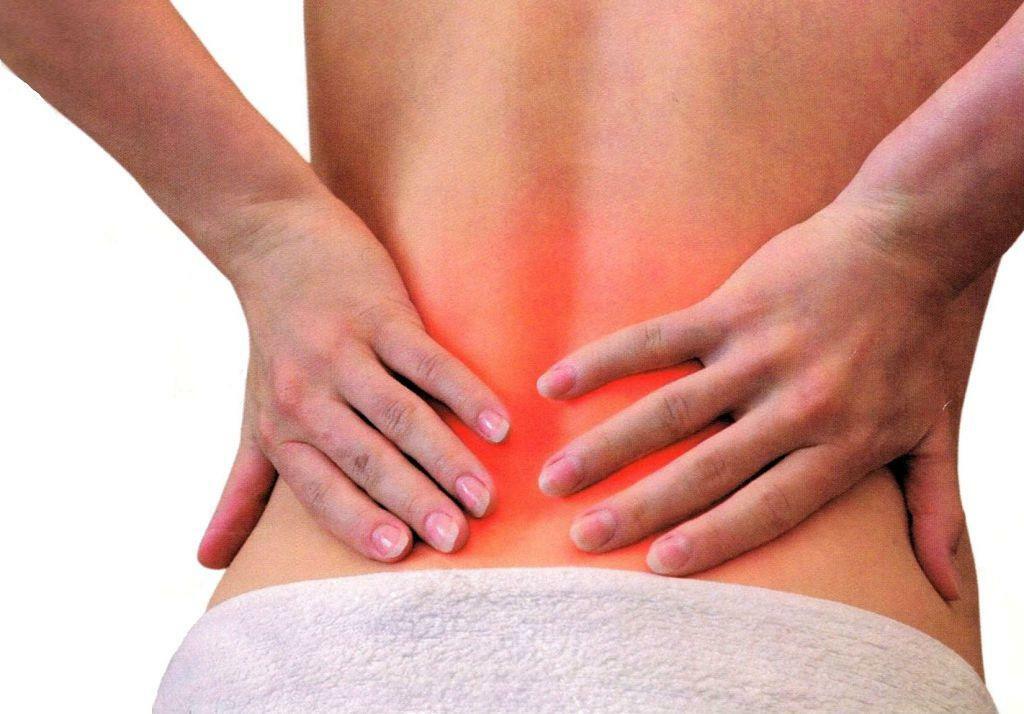The intervertebral hernia is the most common type of hernia in the lumbar region. The most susceptible to this disease are women aged 30 years. The cause of the pathology is rupture of the disc, which occurs under the influence of a heavy load or due to a disturbance in its nutrition. If untreated, the disease can cause disability.

Cimptomy herniated lumbar
material Content
- 1 Features of
- 2 disease symptoms
- 3 Development pain
- 4 reasons pathology
- 5 Consequences
- 5.1 Video - herniated discs of the lumbar symptoms,
- 6 exercise Effective treatments
- 7 Prevention
features of the disease
Lumbarthe department is the most mobile department of the spine. He has the greatest weight load, since he is responsible for the center of equilibrium of the body. This makes him the most vulnerable and traumatized. Lack of physical activity also adversely affects his condition and leads to disruption of his diet.
The lumbar division includes five vertebrae connected by discs. Thanks to them, there is a distribution of gravity on the spine. The structure of the discs is a semi-fluid core surrounded by a fibrous ring.
Strong loads lead to damage to the fibrous ring and its rupture. As a result, a semi-liquid nucleus enters the canal of the spine, which is accompanied by a jamming of the nerve endings. Formed microcracks, which under the influence of the load, increase.
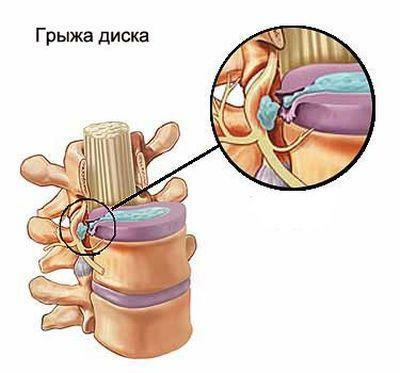
Herniated disc
Symptoms of the disease
The manifestation of symptoms depends on the stage of the disease. Initially, the hernia does not cause much discomfort, and people rarely seek medical help, considering it a manifestation of normal fatigue and pain from physical exertion. When the disease progresses, it is already impossible to ignore it, since the symptoms are quite pronounced:
- Discomfort when bending and tilting.
- Prolonged pain in the lower back.
- Severe pain, giving off in the buttock.
- Feeling tingling and chills.
- Temporary numbness and burning of the legs.
- Problems in the functioning of the intestine and bladder.
- Paralysis.
These symptoms appear during the development of the disease and often depend on the individual characteristics of the body. Some people may for years suffer the initial form of the disease, which does not progress, and is expressed only by dull aching pains. Separate, for example, after injuries in car accidents, can not get out of bed after a few months.

Symptoms of intervertebral disc herniation in the lumbar spine of the
The most common hernia occurs in the lumbosacral segment L5-S1 and the lumbar L4-L5.In the presence of a hernia in the L4-L5 department, the main symptoms of the disease can be added:
- The difficulty of stirring with the big toe.
- Weakening of the calf muscles, which is the cause of the drooping foot.
- Soreness and numbness of the foot in the upper part.
With a hernia in the L5-S1 department, there is no possibility of wiggling and lifting of the fingers, pain gives to the foot or heel, there is no achilles reflex.

The structure of the lumbosacral spine
The nature of the pain specialist can simply establish their cause, but the exact diagnosis is possible only after a complete examination, which includes radiography and computed tomography. These methods allow you to visualize a damaged disk.
Development of pain syndrome
At the initial stage, a person feels dull, aching pain. In the prone position, soreness disappears, but increases with walking. The pain can subside and abruptly appear, and is present throughout the disease.
This initial stage, which can last several years. Most people ignore the pain and refuse to visit a specialist, which leads to the further development of the disease.
The pain begins to increase, give in the thigh and cause numbness of the limbs. A person feels discomfort when bending, raising legs and pressing on the lower back. Begin to appear shooting pain, which can give in the foot, foot or buttock. Discomfort increases with any movement. Relief can be felt only when lying down. When sitting or straight, the pain intensifies.
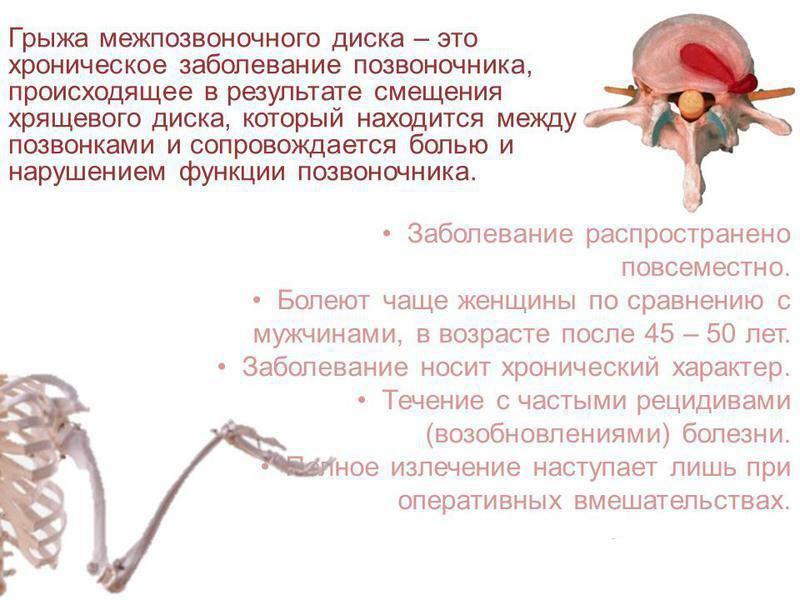
What is a herniated intervertebral disc
Important! For loin disease, characters shooting pain, the duration of which can be up to several weeks.
It is difficult for a person to move around, sit and stand - in any position he feels the greatest pain. But it hurts not only the lower back - pain gives in the buttock, foot and ankle. In the absence of treatment, internal organs begin to suffer, and especially the genitourinary system. This is due to a violation of blood circulation in the small pelvis.
Compression of the nerve roots leads to:
- Weakness in the muscles of the legs and thighs. The patient is difficult to move, jump and crouch.
- Sensation of creeping crawling in the foot zone.
- Feet is always cold.
- Sweating in the place of squeezing the spine.
If the hernia protrudes backward, the spinal cord may be squeezed, leading to severe paralysis. There is a decrease in body temperature, there is swelling and dry skin.
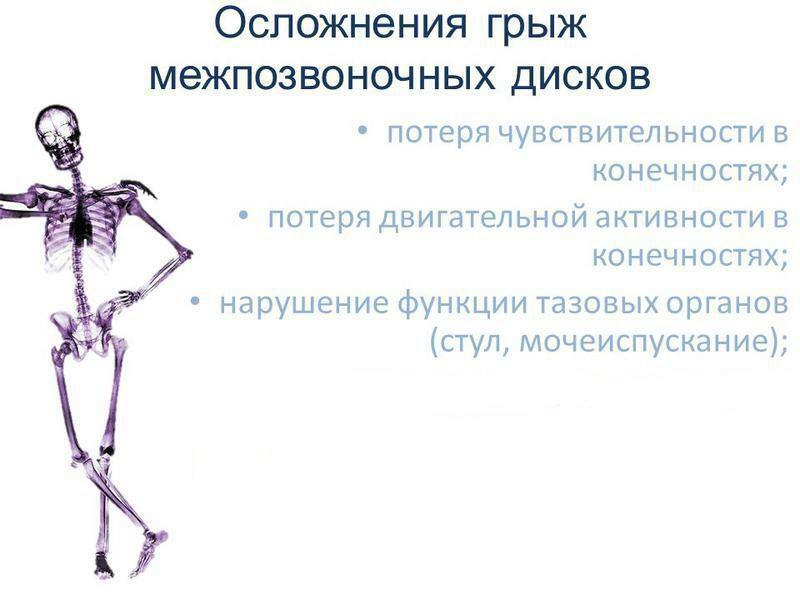
Complications of herniated intervertebral discs
Causes of pathology
There are many reasons for this pathology. It can be the result of osteochondrosis or scoliosis, and also develop after a serious injury. Hernias occur due to the lack of nutrition of intervertebral discs, which is produced through the muscles of the back. If you refuse physical exertion, the muscles become atrophied, which leads to a lack of nutrition of the discs and an increased risk of their injury.
Factors provoking the disease:
- Heavy lifting.
- Great physical activity.
- Falls. Excess weight.
- Sedentary lifestyle.
- Incorrect posture.
- Infections and viruses.
- Natural aging.
- Smoking.
Important! The disease affects women more often, and with growth above 170 cm the risk of a hernia is much higher.
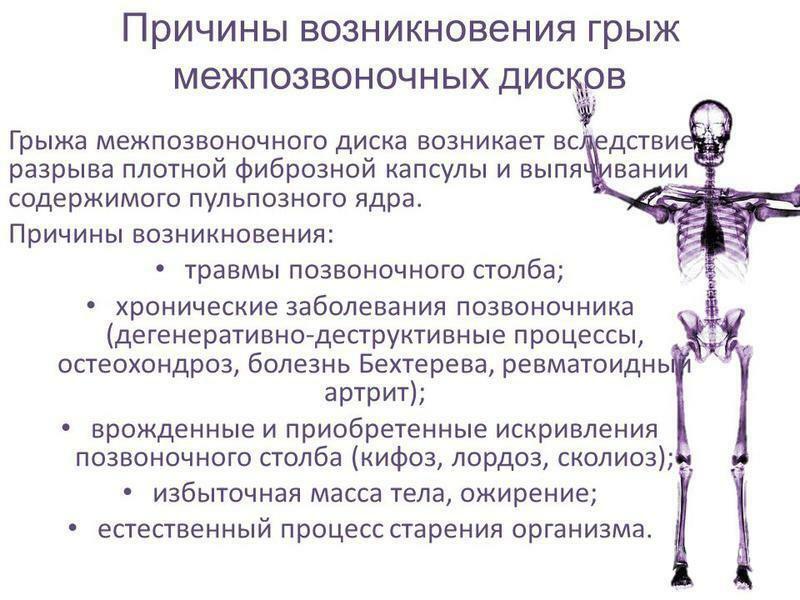
Causes of herniated intervertebral discs
Hernias occur due to sudden increases in severity. If at a younger age, men do not notice aching pain after heavy physical work, then after a while it becomes difficult for them to unbend, lifting loads. Women who wear heavy bags in one hand are also susceptible to this disease, and the weight should be tried to distribute evenly.
Very often a hernia occurs after a fall and injuries, but they manifest themselves in most cases not immediately, but in a couple of years. A person begins to feel a sharp pain, which gives to one of the legs, and rarely can determine what caused such an ailment. Localization of pain depends on the site of spinal injury.
Important! If several parts of the spine are damaged, both the right and left leg will be hurt.
Excess weight is a strong load on the spine. Often obesity is accompanied by diseases of the spine and vascular system, which increases the risk of hernia formation. Also, smoking has a negative effect on blood circulation. Some infectious and inflammatory diseases can also lead to the development of hernias because of the destruction of the intervertebral disk sheath.
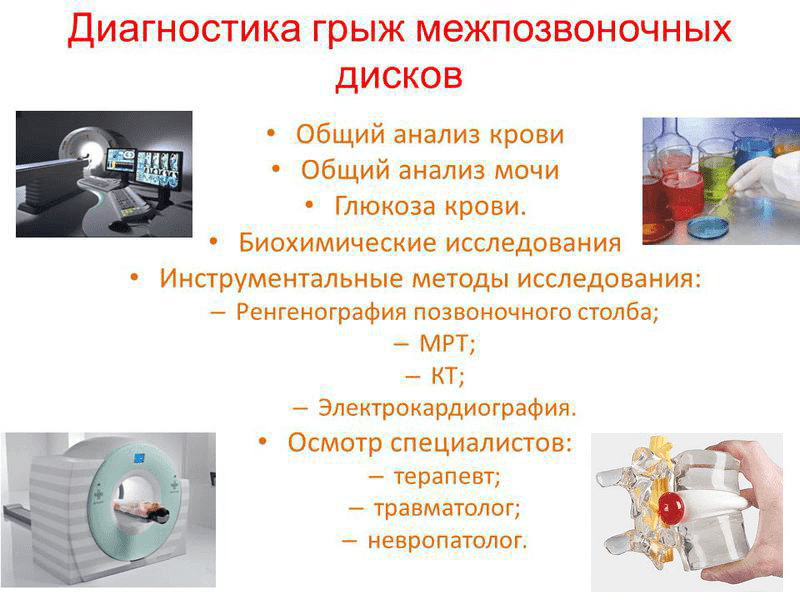
Diagnosis of herniated intervertebral discs
Consequences of
Disease is dangerous for both sexes. Women develop gynecological diseases due to circulatory disorders in the reproductive organs. There may be problems with urination and irregular menstruation. All the organs of the small pelvis suffer, but this does not appear immediately.
Important! In men in the absence of treatment, it is possible to develop impotence and other diseases of the genitourinary system.
Very often this disease is accompanied by intestinal disturbances. Excruciate frequent constipation, pain, giving in the anus, and bloating. Due to high pressure in the affected area, the curvature of the spine develops. You can not bend your back - you may have a hunchback and a stoop. Due to compression of the nerve roots, sensitivity may decrease in the affected areas. At the person begin to grow dumb feet, fingers or femurs.
Sometimes the disease is accompanied by the appearance of lumbago, which causes severe pain. At this time a person can not get out of bed, and with any change of position, soreness increases. The most dangerous consequence is the restriction of mobility and paralysis. Because of severe pain, a person can not lie or sit. The knee jerk can disappear and the mobility of the thumb can be disturbed. If you ignore the treatment, disability is possible.
Video - Intervertebral lumbar hernia symptoms, exercises
Effective treatments for
At the moment, there are two ways to treat pathology - a surgical and conservative method. As practice shows, most patients do not require an operation, but rather conservative methods of treatment. They are aimed at eliminating soreness in the lumbar region. In acute disease it is necessary to observe bed rest and take painkillers.
Usually, the pain is removed within a month. After this, the disease is not fully cured and it is necessary to deal with the strengthening of damaged discs. The next month, in no case, you can not lift weights and do heavy physical work.
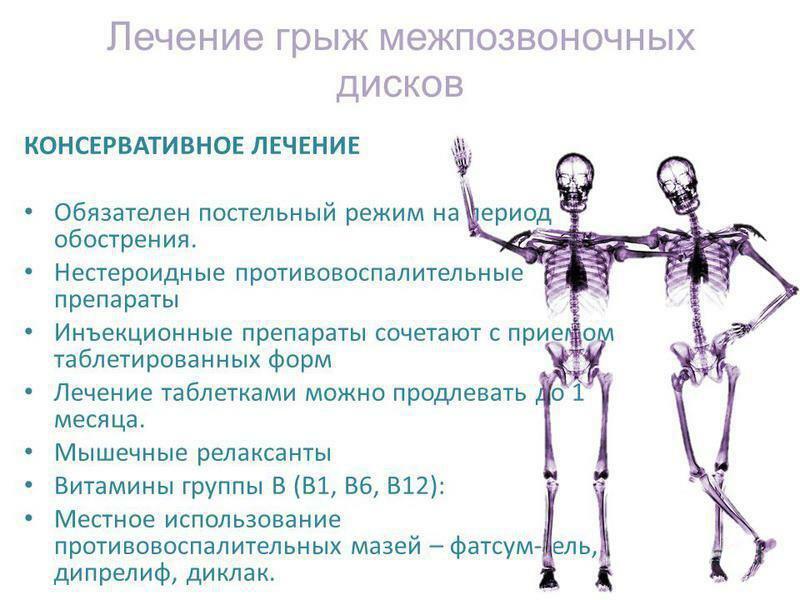
Treatment of herniated intervertebral discs
Most popular drugs
| Spectrum of action | Name of drugs |
|---|---|
| Non-steroidal anti-inflammatory drugs. Pain relief, edema and inflammation | Ibuprofen, Naproxen, Diclofenac |
| Muscle relaxants. Preparations for the removal of muscle spasms | Tubokurarin, Atrakury, Vecuronium, Doxacuria |
| Corticosteroids. Removed edema | Diprospan, Dexamethasone, Prednisone |
| Antidepressants. Block pain and contribute to the development of endorphins, which are analgesic | Amitriptyline, Doxepin, Desipramine |
After the removal of the painful syndrome, great importance is given to curative gymnastics and special physical exercises. Before the patient there is a task - to strengthen the ligamentous apparatus and muscles. A person must independently monitor the health of his back and refuse to lift weights.
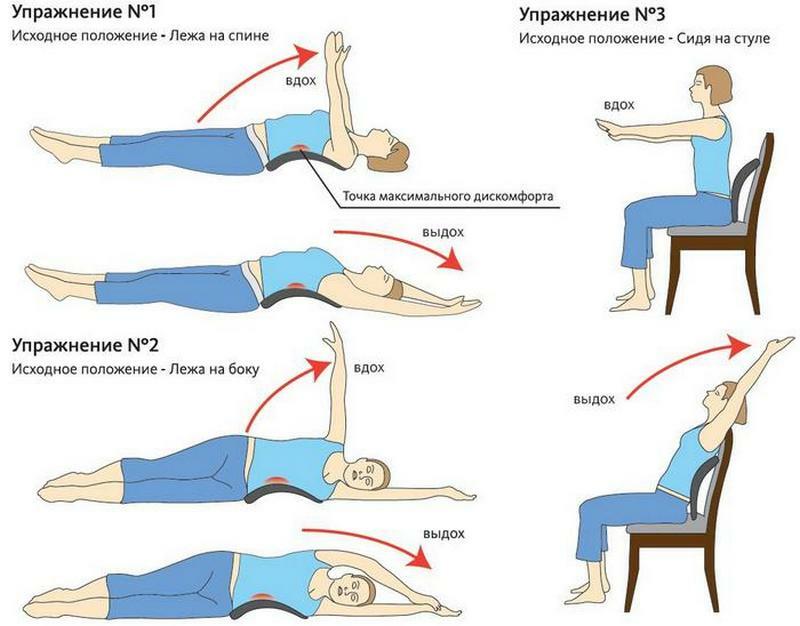
Exercises in the intervertebral hernia of the lumbar spine
Surgery is the extreme method that is used, if it is not possible to reduce the pain or a hernia for a long time, it provoked a malfunction of the internal organs. To remove the hernia, a minimally invasive operation is performed, which is performed under general anesthesia and lasts about half an hour. Thanks to the use of micro-tools, the tissues surrounding the spine are practically not injured, and the recovery of the organism occurs in the shortest possible time.
Carrying out the operation only in 10% of cases does not bring a proper result and after a while, the appearance of new hernias. This is due to a weakened muscle corset. In this case, it is necessary to pay great attention to therapeutic gymnastics and strengthen the back. After this, it is recommended to repeat the operation again, which usually has a positive result.
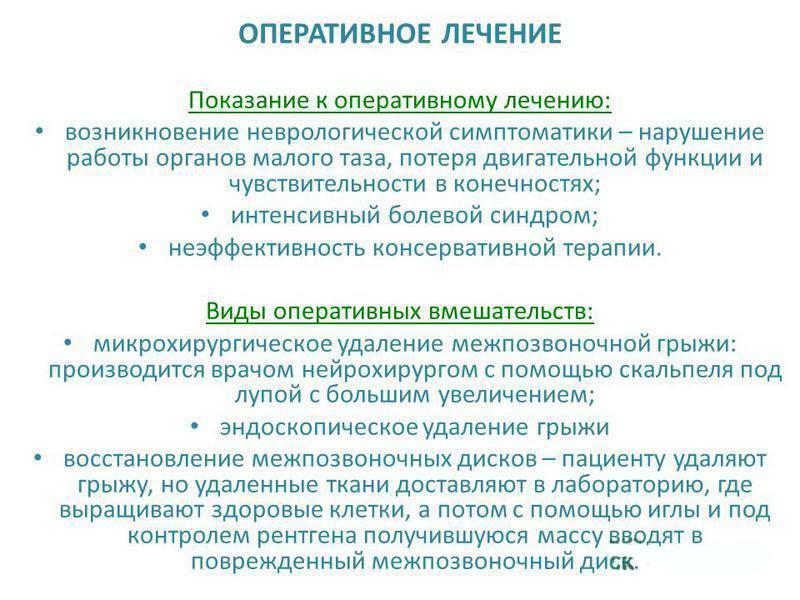
Operative treatment of herniated intervertebral discs
Prevention
First of all, you must give up sedentary lifestyles. It is recommended every day to walk and charge for the spine. Swimming and yoga are useful. After a long work in a sitting position, you need to do physical exercises.
Before lifting weights, you need to bend your knees and keep your back straight. In any case, you can not make too sharp turns and movements. Regular heavy physical exertion accompanied by lifting heavy loads is a risk of spinal pathologies at an early age.
Important! Loads should be moderate if a person wishes to maintain their health.
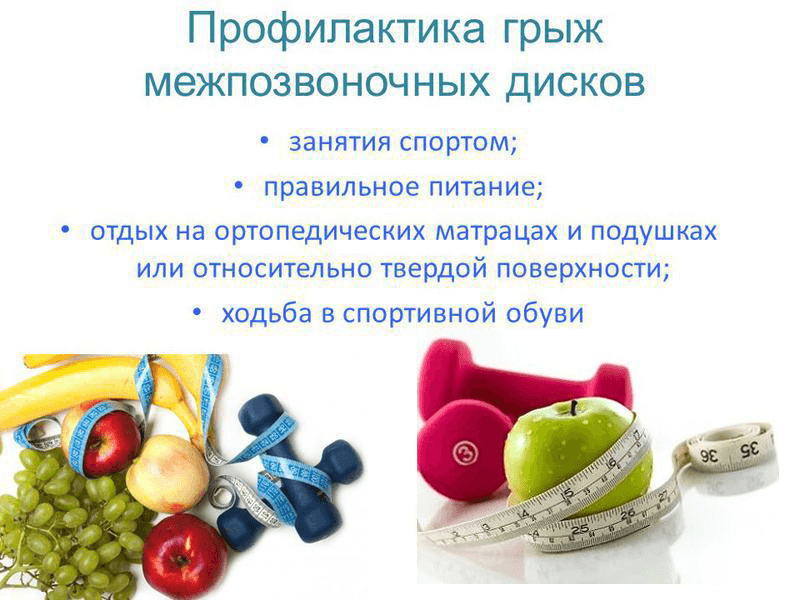
Prophylaxis of herniated intervertebral discs
The correctness of nutrition plays a huge role. It is necessary to refuse fried, smoked and fatty dishes. They lead not only to excess weight, but also the problems of the vascular system. It will be useful to eat foods rich in protein. Choose low-fat meat, and as a heat treatment use quenching, steam or cooking. In the diet must be present vegetables and fruits.

